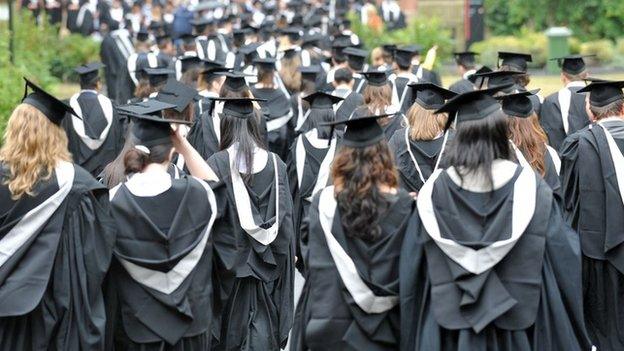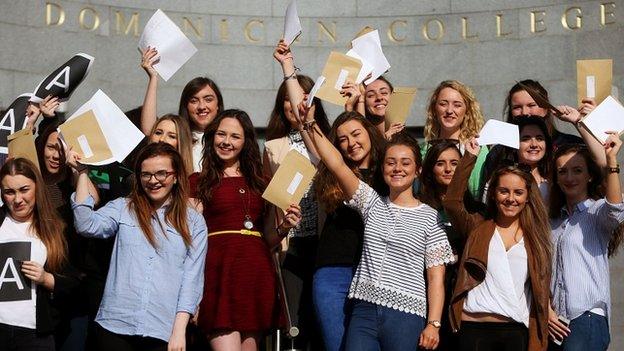Women take record number of university places
- Published

There were more people starting in UK universities this year than ever before
Women are 35% more likely to go to university than men, the widest gap so far, according to annual entry figures.
The Ucas admissions service says record numbers - 532,300 students - began courses in UK universities this autumn.
But there were wide regional variations - with youngsters in London 40% more likely to enter university than those in south-west or north-east England.
Ucas chief Mary Curnock Cook said poor white males should now be the focus of "outreach efforts".
The annual statistics from Ucas show the complete picture of university applications for those starting courses in autumn 2015, with a 3% increase in students compared with last year.
Competing for students
The removal of limits on student numbers saw universities competing for students - and the entry rates show it was easier this year to get into top universities with slightly lower grades.
In students going to the top universities, 26% of entries got places with A-level grades or equivalent below ABB. This was about three percentage points more than last year and 11 percentage points more than four years ago.
The numbers of unconditional offers to students, regardless of their grades, also increased sharply, doubling to 23,400 - or about 2.5% of total offers.
The annual figures show more people entering UK universities than ever before, including increases in students from the UK and overseas.
In England, about 42% of 18- and 19-year-olds will have university places, up by a quarter in the past decade.
Northern Ireland had the highest rate in the UK, with 42.8%. Wales the lowest, with 36.8%.
Ucas does not gather comprehensive figures on students entering higher education in Scotland.
But the admissions service has highlighted the big differences in the characteristics of who gets places.
The most likely are:
women
those living in London
those from more affluent families
those in non-white ethnic groups
Those most likely to be under-represented at university are poor, white males.
White people, proportionate to their numbers in the population, are the least likely ethnic group to go to university, the admissions service says.
And there would be an extra 36,000 male students at university if they entered at the same rate as female students.
London rising
The regional gap is becoming even more accentuated.
Among 18-year-old school leavers, Londoners were already much more likely to get university places than those living anywhere else in England - but their success rate has increased even further and the gap grown wider.
The lowest entry levels are in the South West and North East - and 18-year-olds here, are 40% less likely to go to university than in London.
Ms Curnock Cook said these figures showed a narrowing of the gap between rich and poor, but other differences were widening.
"We have previously highlighted the unacceptably large and widening gap between entry rates for men and women, and this year shows young men, and especially young white men, falling even further behind," she said.
Universities Minister Jo Johnson welcomed the record number of students beginning university, including from poorer families.
"Students from disadvantaged backgrounds are now almost a third more likely to enter higher education than five years ago, but we have much more work to do," he said.
Mr Johnson said the government had an "ambitious programme" to double the proportion of people from disadvantaged backgrounds going to university by 2020.
- Published18 August 2015

- Published26 October 2015
